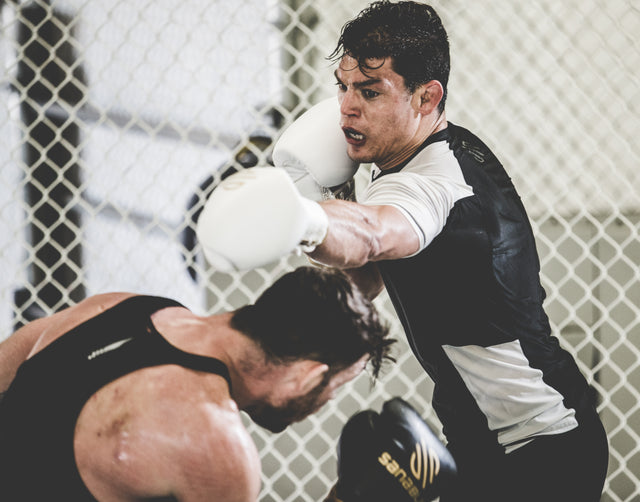Sparring Intensity
Sparring: the best way to get experience in a fight, without actually being in a fight. For those who may not know, sparring is a fight simulation, where practitioners will practice their techniques on one another. Here, they gain experience making reads on their opponent/sparring partner and practice a wide variety of offense, defense, and distance management skills.
But did you know there are multiple ways to spar? If you train, you most likely do. Light, medium, and hard sparring are the main ways that practitioners will spar against one another during training. But what’s the best way?
Consistent with everything in martial arts, there is no one best way to spar - just multiple different methods of doing so. Everyone has their preferences, along with reasons to back up their choice. Each type of sparring offers different benefits and risks. We’ve broken them down and have also provided examples of what each looks like at the end of this article.
Light Sparring
Light sparring, also known as flow sparring, is sparring at a light intensity. Most aspects of a fighter’s game slow down here, to focus on technique, accuracy, and effectiveness. They work on striking with precision, defending incoming attacks, and immediately returning with counter strikes.
Benefits of Light Sparring
When fighters flow spar, they pull their shots. This means that they throw their strikes with normal speed and power (most times usually less), but right before landing, they ease up and tap their opponent instead of hitting hard. This is one of the main benefits of flow sparring: practitioners get to focus on sharpening their offensive and defensive techniques, without fear of getting hurt in training and absorbing any harmful damage. During these rounds, the goal is not to land powerful strikes. You can still focus on landing, but when you throw your strikes, you should be giving your partner enough time to defend the attack and vice versa. This allows both people to get their timing down and polish their techniques. The lower amount of power and damage they face also allows fighters to sharpen their recognition skills. The ability to recognize what an opponent is trying to do and adapting your game plan based on this information is what makes most fighters so good. In these sessions, creativity flows. Fighters become more comfortable with trying out new things and working on their weaknesses without worrying about getting knocked out or injured during training.
Muay Thai fighters are known for their light sparring. In Thailand, it is common to see fighters hitting each other without gloves and shin guards. This is because they have full control over the power they put into their strikes and the technique to land them effectively at all speeds. They kick, knee, and elbow (forearm) without any gear, but don’t often sport any cuts or broken bones from sparring. While Muay Thai fighters do get some hard sparring in, playful sparring is the most common type of sparring for Muay Thai fighters (especially in Thailand). They believe that focusing on proper technique is most important when training for a fight.
In martial arts, very few things are more satisfying to watch than flow sparring between Muay Thai fighters. They have the ability to throw extremely hard strikes (evident in their padwork and heavy bag work) but have enough self-control to ease up on the power during these rounds. In terms of speed, flow rounds usually take place at low paces, but there are higher intensity flow rounds that can still be considered light. As long as the impact of landing is fairly light, it’s flow sparring.
Risks of Flow Sparring
While flow sparring has its advantages due to a sharp focus on technique, accuracy, and low damage absorption, there are risks to be aware of. Since flow sparring is done at a very controlled rate, fighters may be missing out on sharpening their reflexes. They are able to see strikes coming and, by design, have plenty of time to react and defend in training. In a fight, the pace will likely be higher and if they are not used to strikes coming at higher speeds and with more power, they could be slower to react and defend. Fighters may also become too accustomed to the flow sparring pace, which can be detrimental to their performance if the pace of their fight is higher (which it often is higher) and they don’t maintain their conditioning in other ways. In addition, the focus on technique could aid in developing bad habits. For example, if someone drops their hands when punching, flow sparring may condition them to think that bad defense is okay since they are not getting hurt from it. On the other hand, flow sparring could help them identify weak points in their technique, so as long as they spot and work to improve bad techniques, then this risk is mitigated.
Hard Sparring
Hard sparring is the sparring that simulates a fight. Fighters spar at very high paces and throw strikes with the same power they would in a fight.
Benefits of Hard Sparring
In terms of experience, hard sparring gives practitioners good practice for their fights. They attack with the same speed and power as in a real fight, while getting conditioned to absorbing and defending full power strikes coming back at them. Reflexes are honed to be extremely quick, which aids them in their information processing. Analyzing and identifying an opponent’s movements is extremely important, as gameplans get implemented mid-fight to counter opponents.
Dutch kickboxing gyms are notorious for their hard sparring. They spar how they fight, in order to be ready for anything their opponent may present. Training is supposed to be difficult, in order to make the fight seem easy. They make sure of this, often going 100% during sparring. Being able to hold your own during these hard sparring sessions also gives fighters a mental boost. If they face these powerful attacks in training, on a regular basis, then why should they be afraid of what their opponent brings?
While 100% is given in power and speed, it is still a controlled form of sparring. They hit hard, but are not swinging wild. Like Thai fighters, they work on throwing their combinations in a calculated manner. The only difference is that the Dutch-style kickboxers put a lot more power behind their strikes.
Risks of Hard Sparring
Hard sparring is one of the best ways to get ready for a fight. In these rounds, you will experience the same things as you would in an actual fight. It’s the closest thing to the real thing. But there are some big risks of sparring hard. We only have one body and one brain. Due to all of the damage that we absorb and stress that we put on both during training, sparring at this level of intensity can very likely have some negative effects on a fighter’s longevity and career. Since the pace, power, and output level are always going to be high, there will always be an increased risk of injury and amount of recovery needed. Since these sparring sessions and actual fights are very similar, fighters may look to reduce the amount of damage they take. When it comes to development of technique, this could be harmful to growing one’s skill set. Because you’re trying to avoid injury to your brain and body, you may not want to try new things or work on the weaker areas of your game. It can be done, but it may just be harder and take even longer than normal to develop your skills, while taking a lot of extra unnecessary punishment in the process.
Medium Sparring
Medium paced sparring falls in between light sparring and hard sparring. If you are not tapping your opponent with strikes or trying to destroy them with your strikes, you are sparring at a medium intensity.
Benefits of Medium Sparring
The pace of medium sparring is a bit higher than flow sparring and below hard sparring. You train at a good pace, while still working on your offense and defense. In addition, the power you throw with is fairly hard, but controlled at all times. You develop a good sense of what you will face in a fight, but you don’t absorb nearly as much damage as you would from 100% power. Fighters move around at their fight pace, but often pull their strikes slightly to save their partners from additional damage. This allows everyone involved to get some quality work in. Here, fighters can work on the weaker areas of their game, experiment with new techniques, and essentially flow at a high pace, without worrying about getting injured.
Risks of Medium Sparring
As far as risks go, there aren’t many when sparring at a controlled pace with controlled power. The biggest risk of this type of sparring is injury, but unfortunately injury can happen with anything in combat sports. There is a higher risk of injury during hard sparring, so as long as a fighter maintains awareness of their movements, then they should have a pretty good chance of reducing their risk of injury. The only other drawback that can be taken from medium sparring is that it doesn’t offer the same type of reaction training that hard sparring does. Since attacks will not come at full speed/power, the dependence on having super sharp reflexes and reactions will inevitably be lower.
Analysis: What’s the best way to spar?
We’ve outlined the benefits and risks of each type of sparring. But how should you spar? It depends on what your goals are, but in general, mixing in all types of sparring would be the most reasonable choice. By doing so, you will get to experience the benefits that each has to offer. Your sparring doesn’t have to be exactly 33% flow, 33% medium, and 33% hard. Depending on the skill level and amount of experience that you and your training partner have, you may need to adjust your sparring intensity
Note: While this article focuses on striking-only sparring, it can apply to all realms of martial arts sparring. The benefits and risks of these types of sparring apply to the live-rolling rounds of grappling (BJJ, wrestling, judo) and MMA (striking and grappling).
Light and Medium Sparring Videos
Saenchai and Superbon: https://youtu.be/lBOLEJKsna0
Superlek and Cory Sandhagen: https://www.youtube.com/watch?v=R5JnsFTOykE
Superbon: https://www.youtube.com/watch?v=M40NE3DKOs0&t=270s
Sitjaopho technical sparring: https://www.youtube.com/watch?v=stf7FuNoZXY
Hard Sparring Videos
Dutch kickboxing: https://www.youtube.com/watch?v=4M2wPkygyrM
Saenchai matches the intensity of partner: https://www.youtube.com/watch?v=aW6ew2j1ZmQ
Thank you for reading - we hope this article was helpful in explaining the different types of sparring!





0 Comments
There are no comments for this article. Be the first one to leave a message!